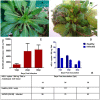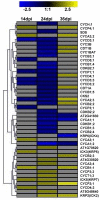Assessing Global Transcriptome Changes in Response to South African Cassava Mosaic Virus [ZA-99] Infection in Susceptible Arabidopsis thaliana
- PMID: 23826319
- PMCID: PMC3694866
- DOI: 10.1371/journal.pone.0067534
Assessing Global Transcriptome Changes in Response to South African Cassava Mosaic Virus [ZA-99] Infection in Susceptible Arabidopsis thaliana
Abstract
In susceptible plant hosts, co-evolution has favoured viral strategies to evade host defenses and utilize resources to their own benefit. The degree of manipulation of host gene expression is dependent on host-virus specificity and certain abiotic factors. In order to gain insight into global transcriptome changes for a geminivirus pathosystem, South African cassava mosaic virus [ZA:99] and Arabidopsis thaliana, 4×44K Agilent microarrays were adopted. After normalization, a log2 fold change filtering of data (p<0.05) identified 1,743 differentially expressed genes in apical leaf tissue. A significant increase in differential gene expression over time correlated with an increase in SACMV accumulation, as virus copies were 5-fold higher at 24 dpi and 6-fold higher at 36 dpi than at 14 dpi. Many altered transcripts were primarily involved in stress and defense responses, phytohormone signalling pathways, cellular transport, cell-cycle regulation, transcription, oxidation-reduction, and other metabolic processes. Only forty-one genes (2.3%) were shown to be continuously expressed across the infection period, indicating that the majority of genes were transient and unique to a particular time point during infection. A significant number of pathogen-responsive genes were suppressed during the late stages of pathogenesis, while during active systemic infection (14 to 24 dpi), there was an increase in up-regulated genes in several GO functional categories. An adaptive response was initiated to divert energy from growth-related processes to defense, leading to disruption of normal biological host processes. Similarities in cell-cycle regulation correlated between SACMV and Cabbage leaf curl virus (CaLCuV), but differences were also evident. Differences in gene expression between the two geminiviruses clearly demonstrated that, while some global transcriptome responses are generally common in plant virus infections, temporal host-specific interactions are required for successful geminivirus infection. To our knowledge this is the first geminivirus microarray study identifying global differentially expressed transcripts at 3 time points.
Conflict of interest statement
Figures







Similar articles
-
Transcriptional analysis of South African cassava mosaic virus-infected susceptible and tolerant landraces of cassava highlights differences in resistance, basal defense and cell wall associated genes during infection.BMC Genomics. 2014 Nov 20;15:1006. doi: 10.1186/1471-2164-15-1006. BMC Genomics. 2014. PMID: 25412561 Free PMC article.
-
Resistance gene analogs involved in tolerant cassava--geminivirus interaction that shows a recovery phenotype.Virus Genes. 2015 Dec;51(3):393-407. doi: 10.1007/s11262-015-1246-1. Epub 2015 Sep 14. Virus Genes. 2015. PMID: 26370397
-
Global analysis of Arabidopsis gene expression uncovers a complex array of changes impacting pathogen response and cell cycle during geminivirus infection.Plant Physiol. 2008 Sep;148(1):436-54. doi: 10.1104/pp.108.121038. Epub 2008 Jul 23. Plant Physiol. 2008. PMID: 18650403 Free PMC article.
-
Discovering host genes involved in the infection by the Tomato Yellow Leaf Curl Virus complex and in the establishment of resistance to the virus using Tobacco Rattle Virus-based post transcriptional gene silencing.Viruses. 2013 Mar 22;5(3):998-1022. doi: 10.3390/v5030998. Viruses. 2013. PMID: 23524390 Free PMC article. Review.
-
Geminiviruses and Plant Hosts: A Closer Examination of the Molecular Arms Race.Viruses. 2017 Sep 15;9(9):256. doi: 10.3390/v9090256. Viruses. 2017. PMID: 28914771 Free PMC article. Review.
Cited by
-
Diverse plant viruses: a toolbox for dissection of cellular pathways.J Exp Bot. 2019 Jun 28;70(12):3029-3034. doi: 10.1093/jxb/erz122. J Exp Bot. 2019. PMID: 30882863 Free PMC article.
-
Comparative transcriptomics analysis reveals defense mechanisms of Manihot esculenta Crantz against Sri Lanka Cassava MosaicVirus.BMC Genomics. 2024 May 2;25(1):436. doi: 10.1186/s12864-024-10315-0. BMC Genomics. 2024. PMID: 38698332 Free PMC article.
-
Transcriptomics of the interaction between the monopartite phloem-limited geminivirus tomato yellow leaf curl Sardinia virus and Solanum lycopersicum highlights a role for plant hormones, autophagy and plant immune system fine tuning during infection.PLoS One. 2014 Feb 28;9(2):e89951. doi: 10.1371/journal.pone.0089951. eCollection 2014. PLoS One. 2014. PMID: 24587146 Free PMC article.
-
Geminiviruses: masters at redirecting and reprogramming plant processes.Nat Rev Microbiol. 2013 Nov;11(11):777-88. doi: 10.1038/nrmicro3117. Epub 2013 Oct 8. Nat Rev Microbiol. 2013. PMID: 24100361 Review.
-
Plum pox virus capsid protein suppresses plant pathogen-associated molecular pattern (PAMP)-triggered immunity.Mol Plant Pathol. 2017 Aug;18(6):878-886. doi: 10.1111/mpp.12447. Epub 2016 Aug 8. Mol Plant Pathol. 2017. PMID: 27301551 Free PMC article.
References
-
- Dardick C (2007) Comparative expression profiling of Nicotiana benthamiana leaves systemically infected with three fruit tree viruses. Mol Plant Microbe Interact 20(8): 1004–1017. - PubMed
-
- Whitham SA, Quan S, Chang HS, Cooper B, Estes B, et al. (2003) Diverse RNA viruses elicit the expression of common sets of genes in susceptible Arabidopsis thaliana plants. Plant J 33(2): 271–283. - PubMed
-
- Whitham SA, Yang C, Goodin MM (2006) Global impact: elucidating plant responses to viral infection. Mol Plant Microbe Interact 19(11): 1207–1215. - PubMed
Publication types
MeSH terms
Substances
LinkOut - more resources
Full Text Sources
Other Literature Sources
Molecular Biology Databases

